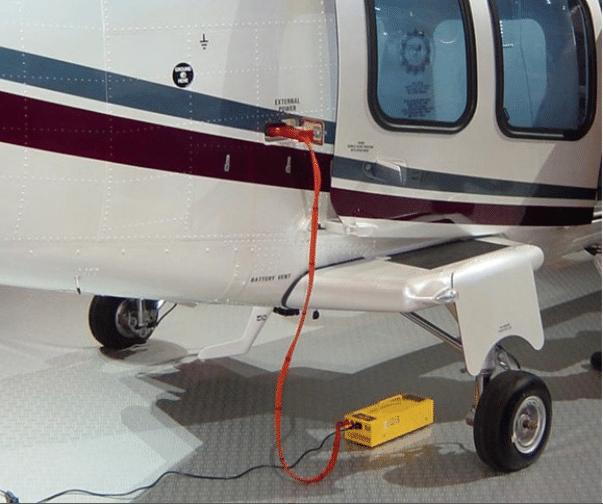
What Is The Difference Between Air Start Units and Ground Power Units?
Ever wondered how those giant airplanes get their engines roaring and all their systems humming before takeoff? Although certain planes come equipped with internal power sources, a significant portion of pre-flight preparation heavily depends on remarkable ground support equipment (GSE).
In today’s article, we will explore two pivotal players in ground support equipment (GSE): Air Start Units (ASUs) vs Ground Power Units (GPUs).
Air Start Units
Picture a scenario where your vehicle requires a boost to start, albeit on a significantly larger magnitude. This is essentially the function of an air start unit for aircraft.
An Air starting unit, also known as a “start cart,” is a self-contained unit that delivers a forceful burst of pressurized air directly to the aircraft’s pneumatic engine starting system. This gust of air initiates the engine’s rotation until it can independently sustain operation.
There exist three primary categories of ASUs:
- Stored air carts: Essentially, these refer to large air reservoirs that contain pre-compressed air.
- Gas turbine units: Gas turbine systems employ a compact gas turbine engine to produce the pressurized air.
- Diesel engine screw compressor units: These units rely on the power of a diesel engine to operate a compressor that generates pressurized air.
Irrespective of the category, ASUs play a crucial role in saving the day when a body aircraft’s batteries have run out or its internal Auxiliary Power Unit (APU), which functions as a mini onboard powerplant, is not operational. They guarantee a seamless and dependable initiation of the engine, thus ensuring that departures occur as planned.
Ground Power Units (GPUs)
Now, let us discuss the various electrical systems responsible for operating an aircraft’s lighting, navigation, entertainment systems, and other functions. This is where Ground Power Units (GPUs) play a crucial role. These are essentially mobile power stations that have been specifically engineered to furnish electricity to aircraft that are parked.
GPUs can be likened to immense power generators, frequently accommodated within a portable vehicle or even integrated directly into the jet bridge stationed at the gate. They furnish the precise electrical power required by an aircraft. By establishing a connection with a GPU, the aircraft can sustain its electrical systems while stationary, eliminating the need to depend on its own engines but yet that can be used to start the engines if needed.
This proves essential during activities such as passenger embarkation, disembarkation, cargo loading, and any maintenance tasks requiring electrical power. Additionally, it aids in the preservation of fuel and mitigates the wear and tear encountered by the engine.
Differences Between ASUs and GPUs
Although the air start unit vs ground power unit are both crucial for ground operations, they fulfill specific objectives:
- In terms of functionality, air start units for aircraft are specifically designed to initiate engine startup by supplying the necessary initial air burst for ignition. In contrast, ground power units are primarily responsible for delivering uninterrupted electrical power to multiple onboard systems.
- ASUs are commonly required in situations where the internal starting system of an aircraft is inoperable. On the other hand, GPUs are regularly employed during ground operations when the airplane requires electrical power without relying on its engines.
Functionality Distinctions
Consider this analogy: ASUs function as jump starters, initiating operations right from the start, while GPUs serve as extension cords, supplying continuous electrical power for a multitude of tasks.
Benefits and Efficiency
Both the air start unit vs ground power unit contribute significantly to the efficiency and safety of aviation operations.
Let’s explore how they contribute:
- Reduced Downtime: By having ASUs readily available, there is no requirement to rely on waiting for a tow or tow truck in the event of an aircraft’s internal starting system failure. Swiftly connecting an ASU promptly initiates the engine rotation, ensuring that the flight schedule remains unaffected.
- Fuel Savings: GPUs obviate the necessity of running aircraft engines during periods of parking, resulting in noteworthy fuel savings and diminished environmental impact.
- Enhanced Safety: Activating supplementary systems such as air conditioning and navigation while stationary is essential to enhance passenger comfort and ensure their safety. Aircraft ground power units guarantee a seamless and enjoyable pre-flight journey.
- Maintenance Advantages: By abstaining from engine usage during ground activities, GPUs assist in reducing engine degradation, resulting in reduced maintenance expenses and increased engine longevity.
For inquiries about GPU services or to learn more about our ground power unit solutions, please contact us today. We’re here to assist with all your aviation ground support equipment needs.
In a Nutshell: Keeping Planes Ready to Fly!
ASUs and GPUs play a crucial role in facilitating seamless airplane takeoffs, operating inconspicuously as indispensable assets.
Through delivering essential initial power and continuous electrical assistance, these reliable ground support equipment champions guarantee efficient, secure, and enjoyable air travel journeys.
Therefore, when observing a bustling aircraft scenario, it is important to acknowledge the unnoticed champions such as ASUs and GPUs that silently ensure the readiness and powering up of aircraft, all set to transport you towards your upcoming adventures!




